A Steering-Following Dynamic Model with Driver’s NMS Characteristic for Human-Vehicle Shared Control
Abstract
1. Introduction
2. Materials and Methods
2.1. Subsection
2.2. Leg NMS Dynamic Model
2.3. Vehicle Dynamic Model
2.4. MPC Controller
| Algorithm 1. MPC controller. |
| Input_U: {Vehicle state variable ; Road trajectory} Step1: Construct vehicle predictive model: Step2: Calculate cost function: Step3: Set constraints: Output_y: {Anticipated steering wheel angle ; Anticipated pedal position } |
2.5. Model Integration
3. Model Parameter Identification and State Observer
3.1. Predicting Process
- (a)
- Initializing the dynamic model: the original HVSC dynamic model demonstrated as continuous state variables should be discretized:where is white noise vector with zero mean value; A and B indicate the parameter vector identified in Equation (26).
- (b)
- Converting the transfer function with the Laplace transform: The relation between input and output is expressed as follows:where and indicate the molecular and denominator polynomial respectively:
- (c)
- Recombining the equation with hierarchical iteration:
3.2. Identifying Process
- (a)
- Calculating quadratic cost functions:
- (b)
- Identifying the parameter vector and parameter matrix :where and represents the estimated parameters at time t. Notably, the parameters identified are ,,,,,,,,,,,,,,,,,, and . Others are known.
3.3. Posting Process
4. Field Experiments
4.1. Experimental Facilities
4.2. Experimental Participants
4.3. Experimental Scenario
4.4. Experimental Procedure
5. Model Verification with Experimental Results
5.1. Activation-to-Force Processing
5.2. Model Verification Results
5.3. Model Verification Analysis
6. Conclusions
Author Contributions
Funding
Conflicts of Interest
Abbreviations
| HVSC | Human-vehicle shared control |
| AV | Autonomous vehicle |
| NMS | Neuromuscular |
| MPC | Model predictive control |
| 2DOF | Two-degree-of-freedom |
| HLS | Hierarchical least square |
| UKF | Unscented Kalman Filter |
| GTO | Golgi tendon organs |
| MIMO | Multi-input multi-output |
| EMG | Electromyography |
| MVC | Maximum voluntary contraction |
| RMS | Average rectified value |
References
- SAE International. Taxonomy and Definitions for Terms related to Driving Autonomous Systems for on-road Motor Vehicles; J3016; SAE International: New York, NY, USA, 2016. [Google Scholar]
- Noh, S.; Park, B.; An, K.; Koo, Y.; Han, W. Co-Pilot Agent for Vehicle/Driver Cooperative and Autonomous Driving. ETRI J. 2015, 37, 1032–1043. [Google Scholar] [CrossRef]
- Abbink, D.A.; Mulder, M.; Van der Helm, F.C.; Mulder, M.; Boer, E.R. Measuring neuromuscular control dynamics during car following with continuous haptic feedback. IEEE Trans. Syst. Man Cybern. Part B (Cybern.) 2011, 41, 1239–1249. [Google Scholar] [CrossRef] [PubMed]
- Olivari, M.; Nieuwenhuizen, F.M.; Bülthoff, H.H.; Pollini, L. Identifying time-varying neuromuscular system with a recursive least-squares algorithm: a Monte-Carlo simulation study. In Proceedings of the 2014 IEEE International Conference on Systems, Man, and Cybernetics (SMC), San Diego, CA, USA, 5–8 October 2014. [Google Scholar]
- Golkar, M.A.; Jalaleddini, K.; Tehrani, E.S.; Kearney, R.E. Identification of time-varying dynamics of reflex EMG in the ankle plantar flexors during time-varying, isometric contractions. In Proceedings of the 2015 37th Annual International Conference of the IEEE Engineering in Medicine and Biology Society (EMBC), Milan, Italy, 25–29 August 2015; pp. 6744–6747. [Google Scholar]
- Marouf, A.; Pudlo, P.; Sentouh, C.; Djemaï, M. Investigation of the driver’s arm viscoelastic properties during steering vehicle maneuver. IEEE Trans. Syst. Man Cybern. Syst. 2016, 47, 1030–1036. [Google Scholar] [CrossRef]
- Lv, C.; Wang, H.; Cao, D.; Zhao, Y.; Auger, D.J.; Sullman, M.; Matthias, R.; Skrypchuk, L.; Mouzakitis, A. Characterization of Driver Neuromuscular Dynamics for Human–Automation Collaboration Design of Automated Vehicles. IEEE/ASME Trans. Mechatron. 2018, 23, 2558–2567. [Google Scholar] [CrossRef]
- Bi, L.; Wang, M.; Wang, C.; Liu, Y. Development of a driver lateral control model by integrating neuromuscular dynamics into the queuing network-based driver model. IEEE Trans. Intell. Transp. Syst. 2015, 16, 2479–2486. [Google Scholar] [CrossRef]
- Christopher, N.; Cole, D.J. Development of a novel model of human-vehicle steering control incorporating sensory dynamics. Dyn. Veh. Roads Tracks 2016, 43, 57–66. [Google Scholar]
- Kolekar, S.; Mugge, W.; Abbink, D. Modeling intradriver steering variability based on sensorimotor control theories. IEEE Trans. Hum. Mach. Syst. 2018, 48, 291–303. [Google Scholar] [CrossRef]
- Zhao, Y.; Zhao, F.; Tian, Y. The shared steering controller inspired by the neuromuscular system of drivers. In Proceedings of the 2018 Chinese Control and Decision Conference (CCDC), Shenyang, China, 9–11 June 2018; pp. 3433–3438. [Google Scholar]
- Mars, F.; Chevrel, P. Modelling human control of steering for the design of advanced driver assistance systems. Annu. Rev. Control 2017, 44, 292–302. [Google Scholar] [CrossRef]
- Lixin, Y.; Huang, Z.; Chaozhong, W. Selection of driving mode for autonomous vehicle based on danger situation recognition. J. South China Univ. Technol. (Nat. Sci. Ed.) 2016, 44, 140–145. [Google Scholar]
- Sendler, J.; Trutschel, R.; Augsburg, K.; Schumann, N.P.; Scholle, H.C. Methods of evaluating and developing pedal and brake characteristics. ATZ Worldw. 2009, 111, 60–66. [Google Scholar] [CrossRef]
- Endo, K.; Herr, H. A model of muscle–tendon function in human walking at self-selected speed. IEEE Trans. Neural Syst. Rehabil. Eng. 2013, 22, 352–362. [Google Scholar] [CrossRef] [PubMed]
- Endo, K.; Paluska, D.; Herr, H. A quasi-passive model of human leg function in level-ground walking. In Proceedings of the 2006 IEEE/RSJ International Conference on Intelligent Robots and Systems, Beijing, China, 9–15 October 2006; pp. 4935–4939. [Google Scholar]
- Qashqai, A.; Ehsani, H.; Rostami, M. A hill-based EMG-driven model to estimate elbow torque during flexion and extention. In Proceedings of the 2015 22nd Iranian Conference on Biomedical Engineering (ICBME), Tehran, Iran, 25–27 November 2015; pp. 166–171. [Google Scholar]
- Pick, A.; Cole, D. A Mathematical Model of Driver Steering Control Including Neuromuscular Dynamics. J. Dyn. Syst. Meas. Control 2008, 130, 031004. [Google Scholar] [CrossRef]
- Pick, A.J.; Cole, D.J. Dynamic properties of a driver’s arms holding a steering wheel. Proc. Inst. Mech. Eng. Part D J. Automob. Eng. 2007, 221, 1475–1486. [Google Scholar] [CrossRef]
- Kandel, E.R.; Schwartz, J.H. Principles of Neural Science; McGraw Hill: New York, NY, USA, 2000; Volume 4, pp. 1227–1246. [Google Scholar]
- Abbink, D.A. Neuromuscular Analysis of Haptic Gas Pedal Feedback during Car Following. Delft. Ergon. 2008, 51, 1710–1720. [Google Scholar]
- Van der Helm, F.C.; Schouten, A.C.; de Vlugt, E.; Brouwn, G.G. Identification of intrinsic and reflexive components of human arm dynamics during postural control. J. Neurosci. Methods 2002, 119, 1–14. [Google Scholar] [CrossRef]
- Rajamani, R. Vehicle Dynamics and Control. J. Jpn. Fluid Power Syst. Soc. 2012, 39, 111. [Google Scholar]
- Snider, J.M. Automatic Steering Methods for Autonomous Automobile Path Tracking; Tech. Rep. CMU-RITR-09-08; Robotics Institute: Pittsburgh, PA, USA, 2009. [Google Scholar]
- Walter, E. Identifiability of State Space Models: With Applications to Transformation Systems; Springer Science & Business Media: Berlin, Germany, 2013. [Google Scholar]
- Bai, F.; Chew, C.M.; Li, J.; Shen, B.; Lubecki, T.M. Muscle force estimation method with surface EMG for a lower extremities rehabilitation device. In Proceedings of the 2013 IEEE 13th International Conference on Rehabilitation Robotics (ICORR), Seattle, WA, USA, 24–26 June 2013; pp. 1–6. [Google Scholar]
- Ding, F.; Liu, Y.; Bao, B. Gradient-based and least-squares-based iterative estimation algorithms for multi-input multi-output systems. Proc. Inst. Mech. Eng. Part I J. Syst. Control Eng. 2012, 226, 43–55. [Google Scholar] [CrossRef]
- Xiang, L.; Xie, L.; Liao, Y.; Ding, R. Hierarchical least squares algorithms for single-input multiple-output systems based on the auxiliary model. Math. Comput. Model. 2010, 52, 918–924. [Google Scholar] [CrossRef]
- Ren, H.; Chen, S.; Zhao, Y.; Liu, G.; Yang, L. State observer-based sliding mode control for semi-active hydro-pneumatic suspension. Veh. Syst. Dyn. 2016, 54, 168–190. [Google Scholar] [CrossRef]
- Lin, W.; Rong, F.; Cheng, Z.; Xiaowei, Y. Driving fatigue research based on wireless body area network and approximate physiological entropy of physiological signals. Chin. J. Biomed. Eng. 2017, 76, 34–40. [Google Scholar]
- Liu, Y.; Ji, X.; Ryouhei, H.; Takahiro, M.; Lou, L. Function of shoulder muscles of driver in vehicle steering maneuver. Sci. China Technol. Sci. 2012, 55, 3445–3454. [Google Scholar] [CrossRef]
- Brook, S.; Freeman, R.; Rosala, G.; Campean, F.; Dixon, N. Ergonomic Data measuring system for driver-pedals interaction. SAE Int. J. Passeng. Cars Mech. Syst. 2009, 2, 1071–1078. [Google Scholar] [CrossRef]
- Lasschuit, J.; Lam, M.; Mulder, M.; van Paassen, R.; Abbink, D. Measuring and modeling neuromuscular system dynamics for haptic interface design. In Proceedings of the AIAA Modeling and Simulation Technologies Conference and Exhibit, Honolulu, HI, USA, 18–21 August 2008; p. 6543. [Google Scholar]

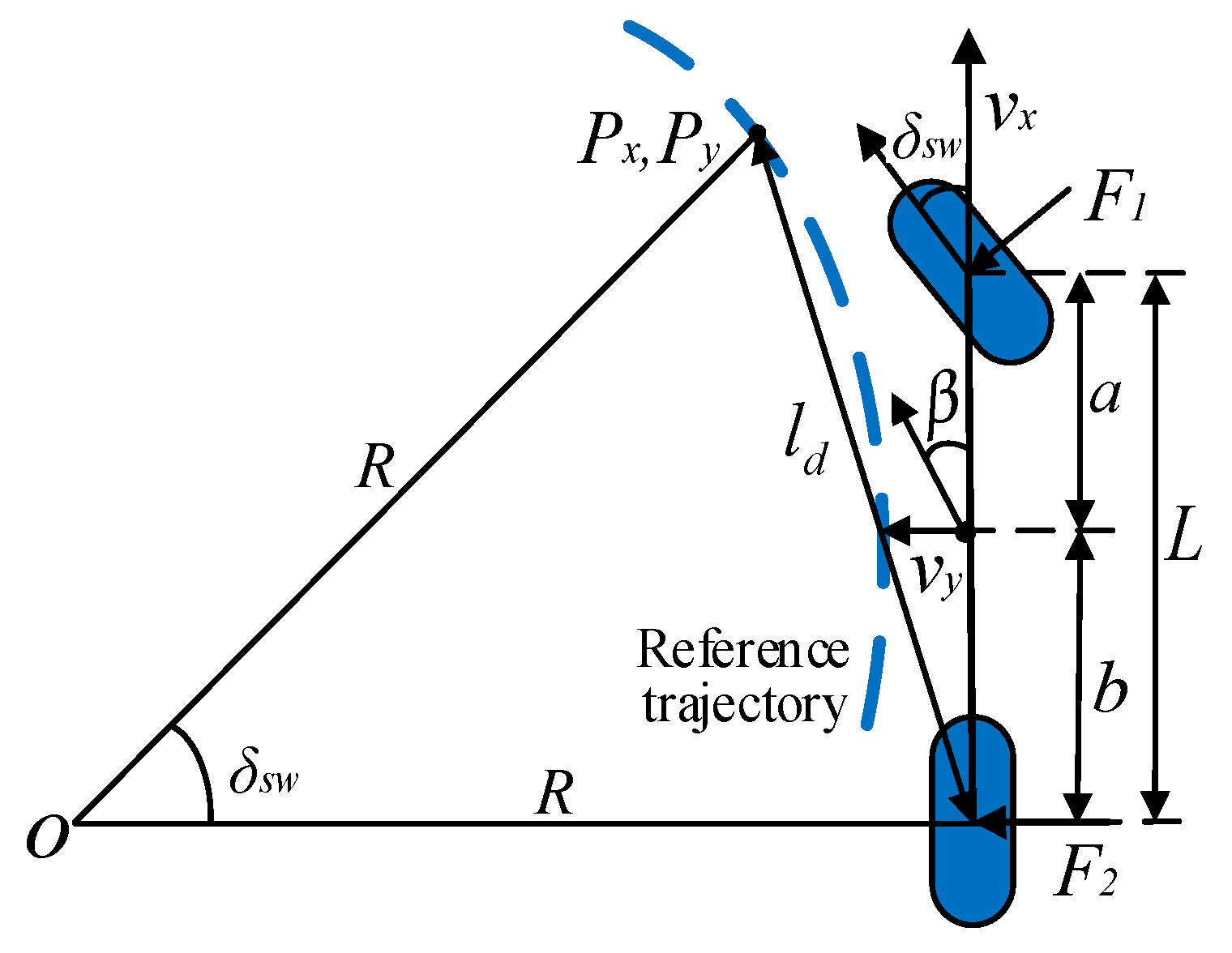
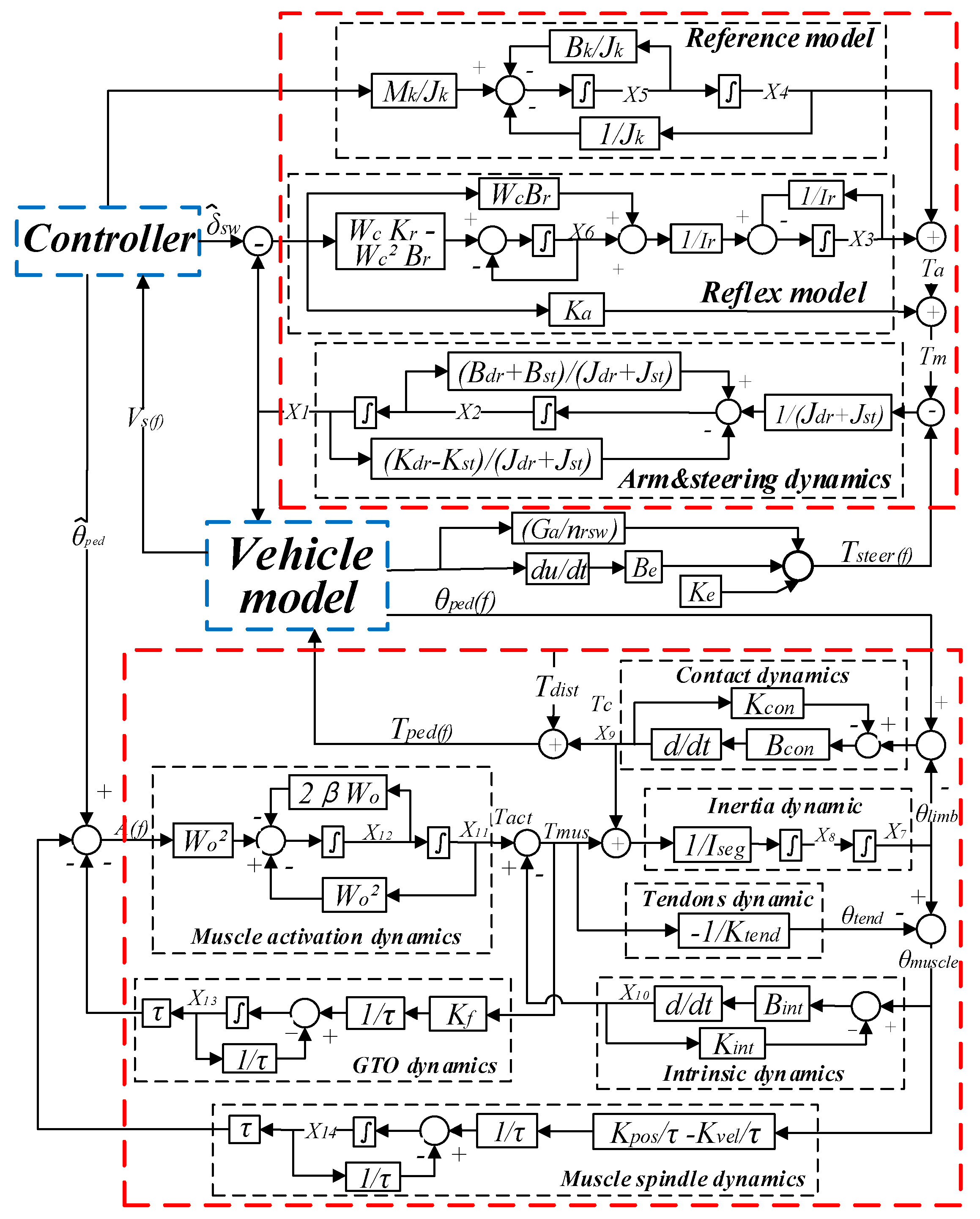
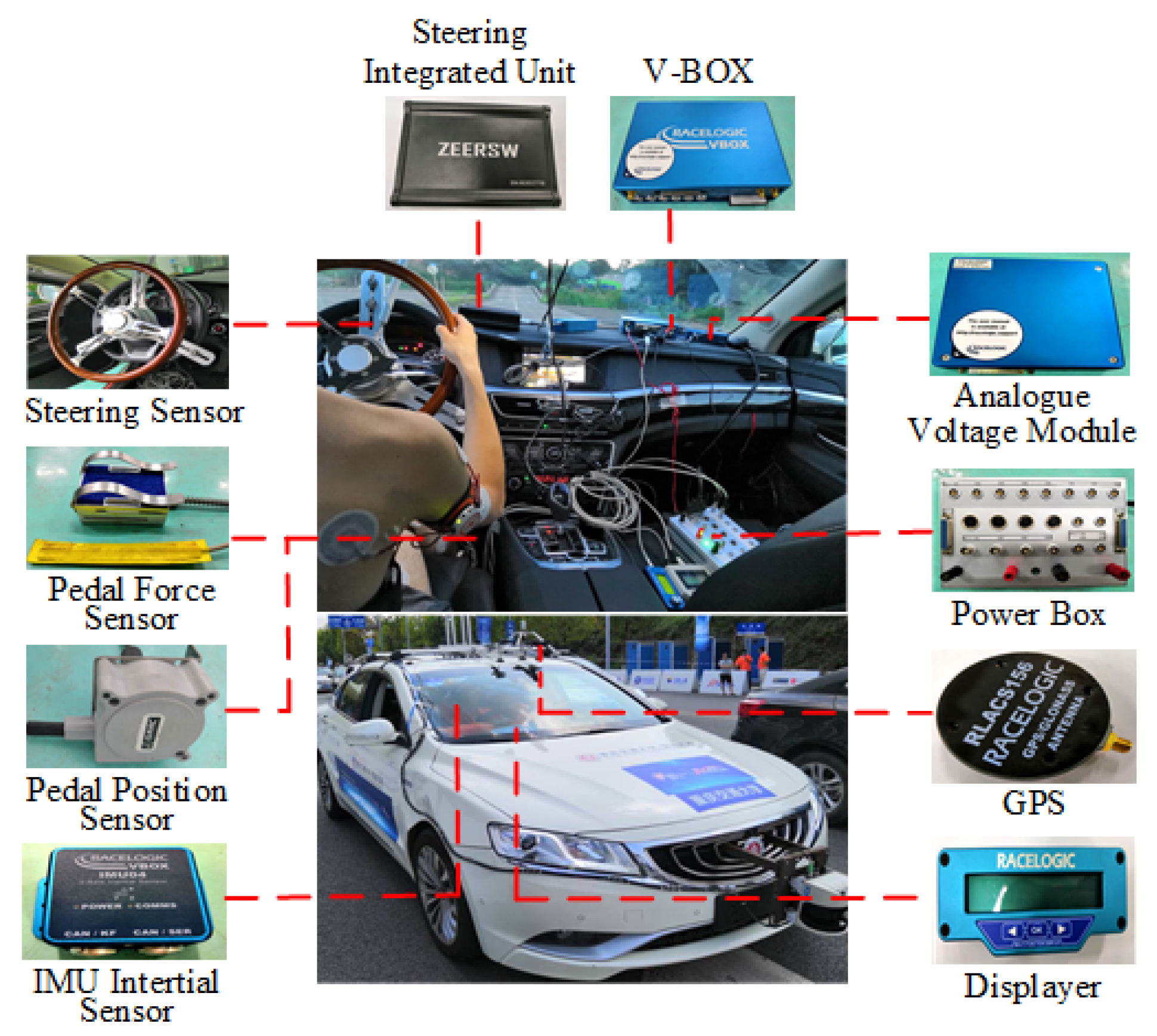
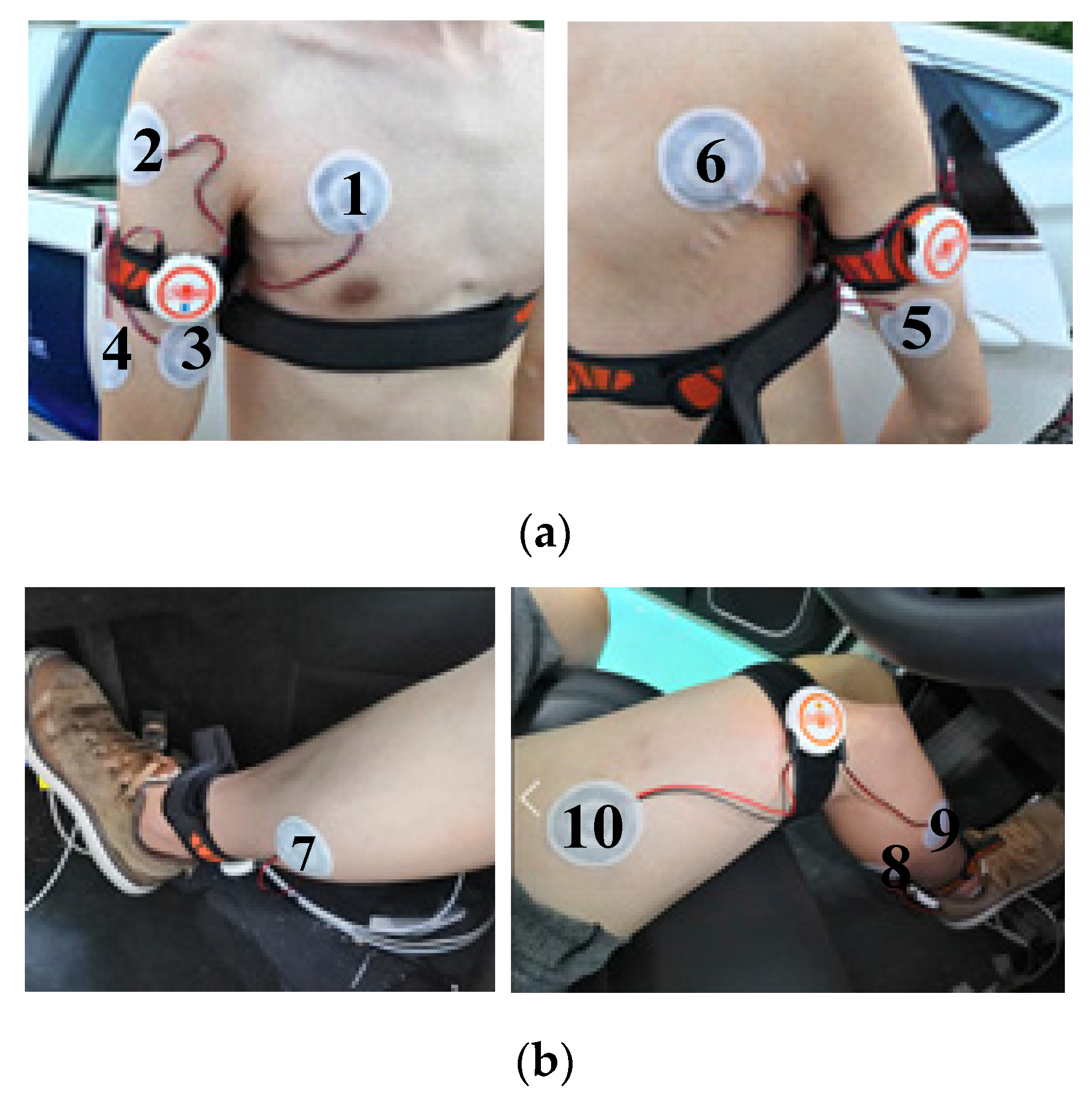


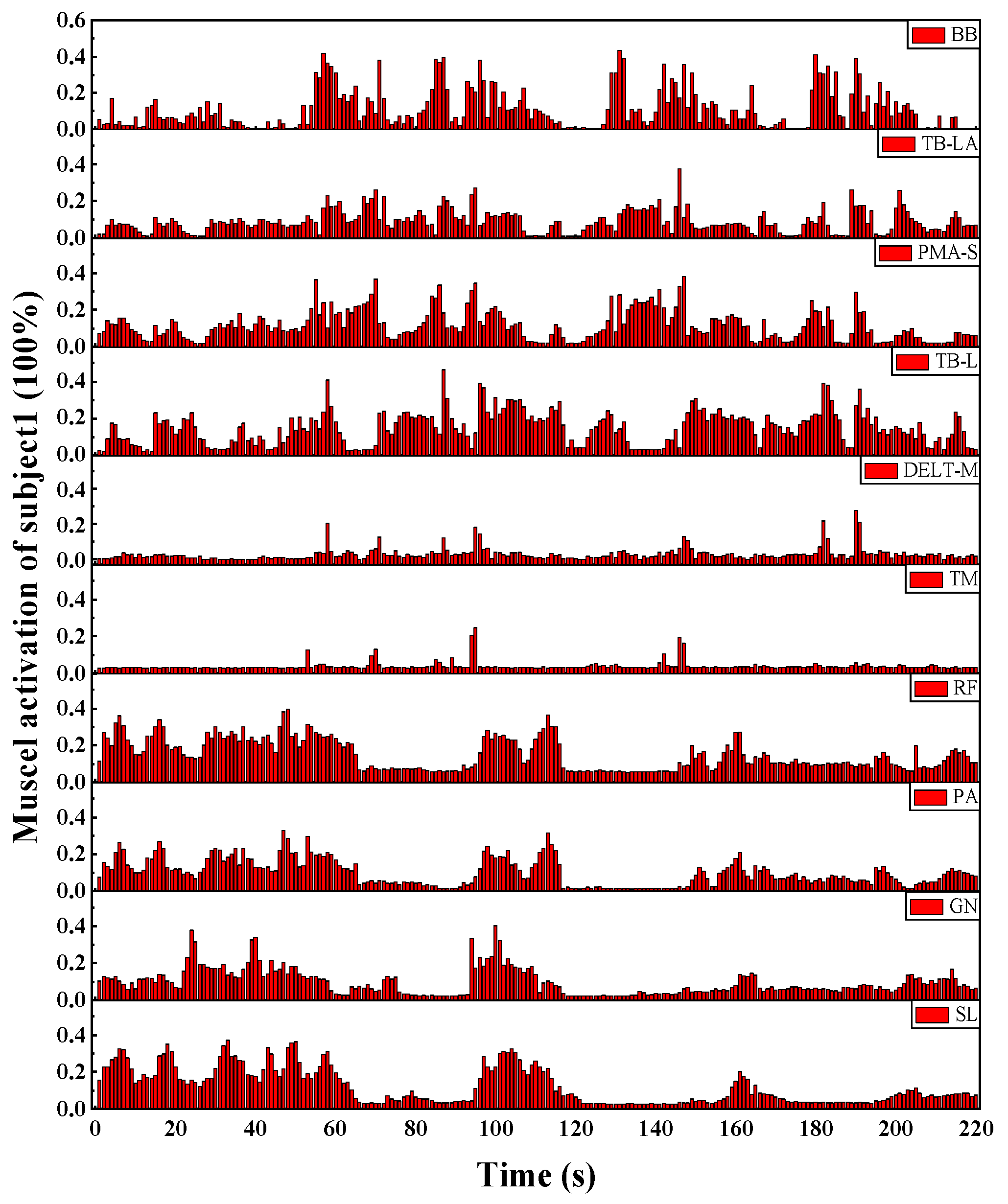
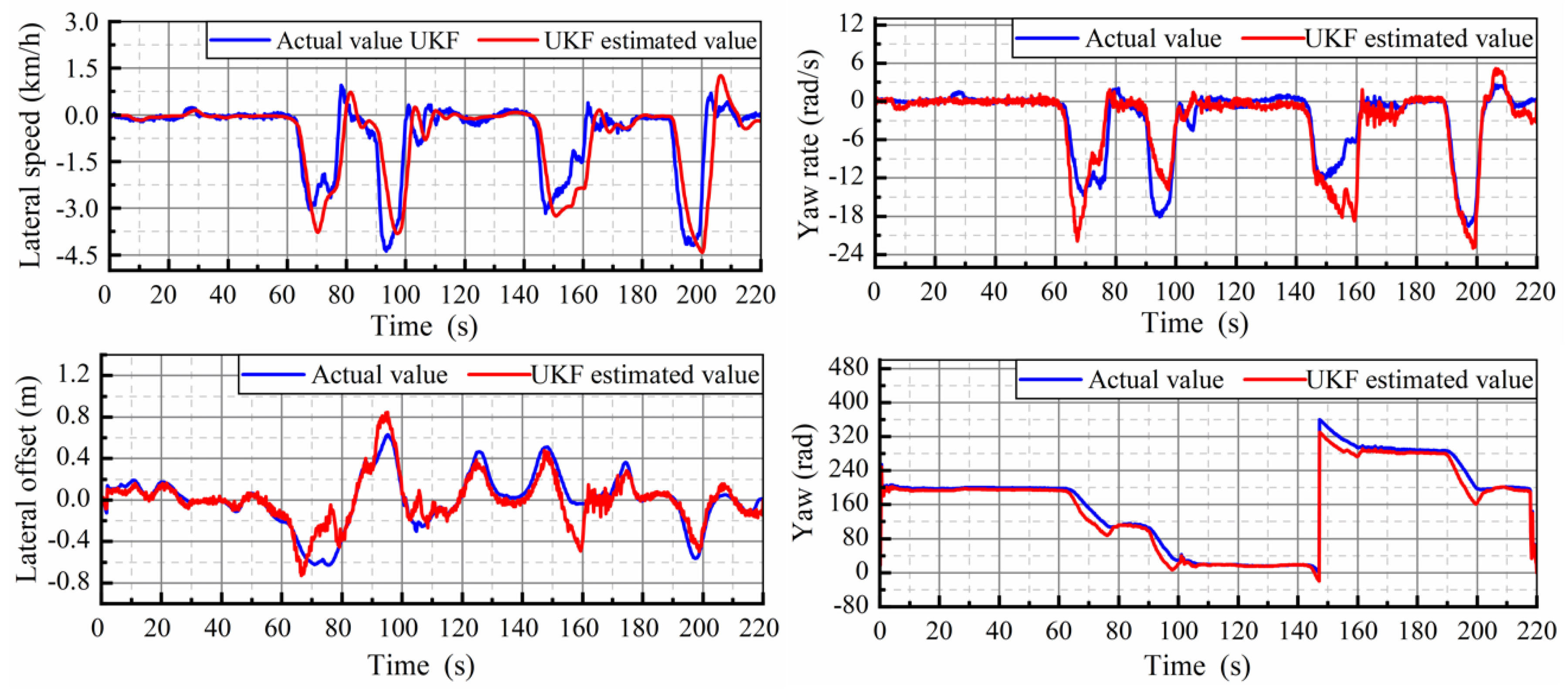
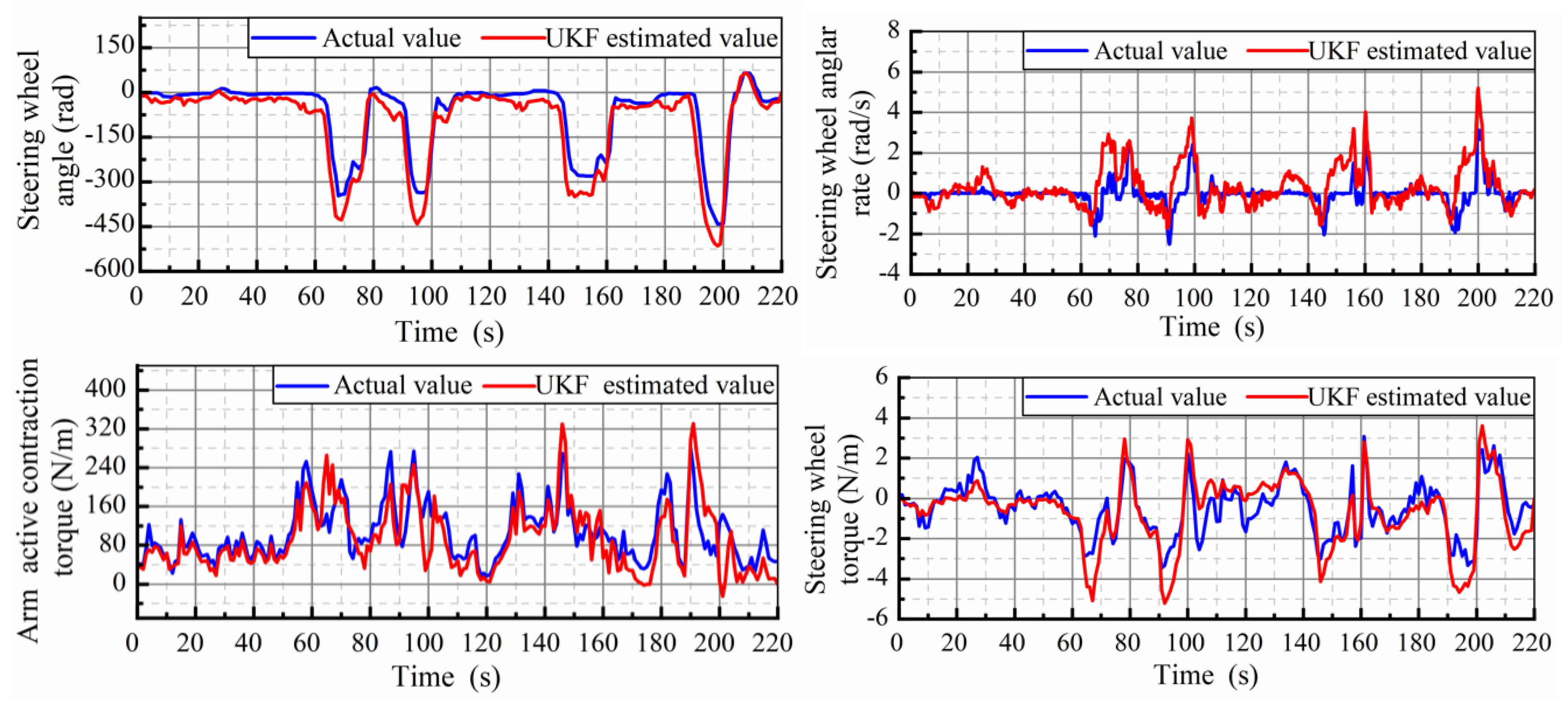
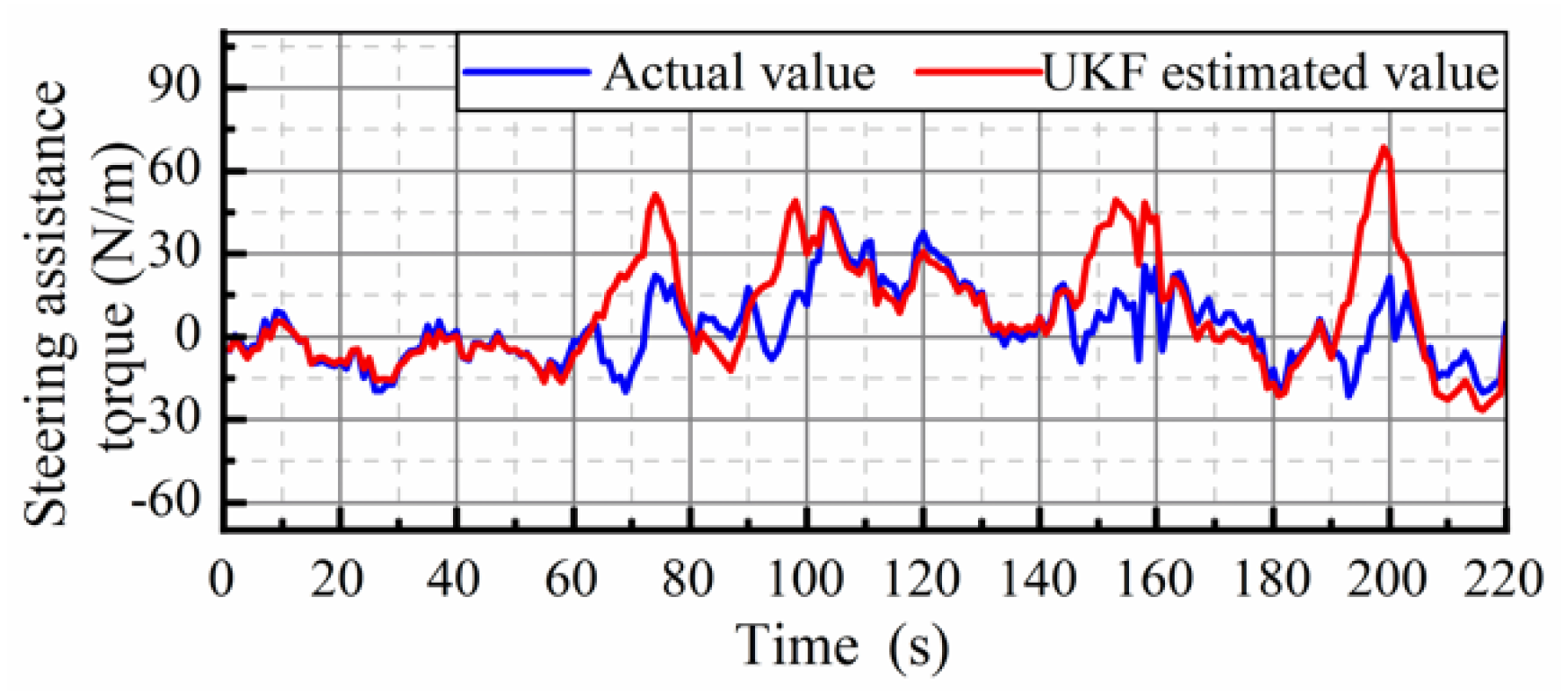
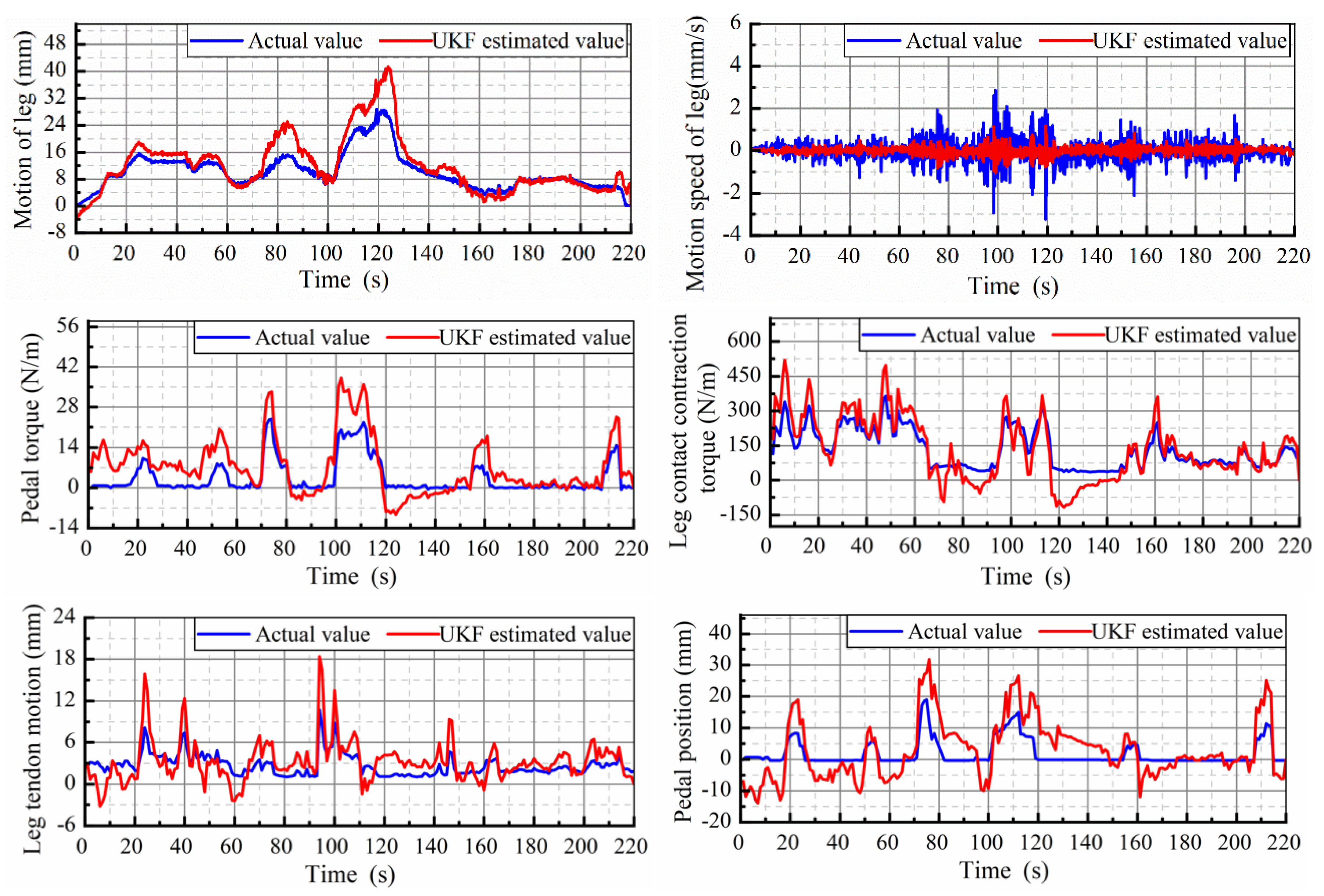

| Symbol | Description | Value |
|---|---|---|
| Jst | Steering wheel inertia | 0.1395 (kg m2) |
| Bst | Steering wheel damper | 1.56 (Nm s/rad) |
| Kst | Steering wheel spring | 2.29 (Nm/rad) |
| Ka | Active stiffness | −1920 (Nm/rad) |
| Jdr | Arm inertia | 0.172 (kg m2) |
| Bdr | Arm damping | 1.032 (Nm s/rad) |
| Kdr | Arm spring | 60.707 (Nm/rad) |
| Kr | Arm reflection stiffness | 3.423 (Nm s/rad) |
| Br | Arm reflection damping | 1.69 (Nm/rad) |
| τdel | Inherent time delay | 0.04 (s) |
| Kpos | Stretch feedback gain | 0.52 (Nm/rad) |
| Ktend | Tendon stiffness | 2799 (Nm/rad) |
| f0 | Eigen-frequency | 1.1 (Hz) |
| Iseg | Motion of the inertia | 105.5 (g/m2) |
| Kf | GTO feedback gain | 1.18 (Nm/rad) |
| Kvel | Stretch velocity feedback gain | 40.4 (Nm/rad) |
| Kint | Co-contraction stiffness | 334 (Nm/rad) |
| Bint | Co-contraction damping | 19.4 (Nm/rad) |
| Kcon | Contact elasticity | 1033 (Nm/rad) |
| Bcon | Contact viscosity | 11.2 (Nm /rad) |
| Symbol | Description | Value |
|---|---|---|
| Iz | Yaw inertia | 4192 (kg m2) |
| vx | Longitudinal speed | 2.29 (m/s) |
| k1 | Cornering stiffness of the front tires | 93360 (N/rad) |
| k2 | Cornering stiffness of the rear tires | 57340 (N/rad) |
| a | Front axle length | 1.18 (m) |
| b | Rear axle length | 1.58 (m) |
| m | Body mass | 1498 (kg) |
| xl | Look-ahead distance | 12 (m) |
| nrsw | Steering gear ratio | 18 |
| Number | Muscle Name | Functionality |
|---|---|---|
| 1 | Sternocostal portion of Pectoralis major (PMA-S) | Steering right |
| 2 | Middle deltoid (DELT-M) | Steering right |
| 3 | Biceps brachii (BB) | Steering left |
| 4 | Lateral head of triceps brachii (TB-LA) | Steering right |
| 5 | Long head of triceps brachii (TB-L) | Steering left |
| 6 | Teres major (TM) | Steering left |
| 7 | Rectus femoris (RF) | Speed control |
| 8 | Patellar anterior (PA) | Speed control |
| 9 | Gastrocnemius muscle (GN) | Speed control |
| 10 | Soleus muscle (SL) | Speed control |
| Subject | Range | Initial | Sub1 | Sub2 | Sub3 | |
|---|---|---|---|---|---|---|
| Prameter | ||||||
| Jdr (kg/m2) | [0.03~0.14] | 0.172 | 0.162 | 0.097 | 0.125 | |
| Bdr (Nm/rad) | [0.1~2.5] | 1.032 | 0.989 | 0.91 | 0.932 | |
| Kdr (Nm/rad) | [20~90] | 60.707 | 58.873 | 49.105 | 52.34 | |
| Br (Nm s/rad) | [0.5~2] | 1.69 | 1.532 | 0.9 | 1.472 | |
| Kr (Nm/rad) | [2~30] | 3.424 | 2.502 | 2.15 | 2.27 | |
| Ktend (Nm/rad) | [1799–3988] | 2799 | 2771 | 2096 | 2459 | |
| Kf (Nm/rad) | [−0.81~1.78] | 1.18 | 1.27 | 1.36 | 1.32 | |
| Kvel (Nm/rad) | [−0.40~48.6] | 40.4 | 41.51 | 33.12 | 38.74 | |
| Kint (Nm/rad) | [191~505] | 334 | 318 | 381 | 397 | |
| Bint (Nm/rad) | [16~22.2] | 19.4 | 19.3 | 16.1 | 17.8 | |
| Kcon (Nm/rad) | [615~1143] | 1033 | 1022 | 893 | 921 | |
| Bcon (Nm/rad) | [10.6~11.7] | 11.2 | 11.32 | 10.87 | 10.91 | |
| No. | Parameter | Coefficient | No. | Parameter | Coefficient |
|---|---|---|---|---|---|
| 1 | Lateral speed | 0.8621 | 9 | Steering assistance torque | 0.7156 |
| 2 | Yaw rate | 0.8246 | 10 | Motion of leg | 0.82323 |
| 3 | Lateral offset | 0.7653 | 11 | Movement speed of leg | 0.74421 |
| 4 | Yaw | 0.8956 | 12 | Pedal torque | 0.7021 |
| 5 | Steering wheel angle | 0.8663 | 13 | Leg contraction torque | 0.74421 |
| 6 | Steering wheel angular rate | 0.8421 | 14 | Leg tendon motion | 0.746 |
| 7 | Arm active contraction torque | 0.73421 | 15 | Pedal position | 0.716 |
| 8 | Steering wheel torque | 0.8646 |
© 2020 by the authors. Licensee MDPI, Basel, Switzerland. This article is an open access article distributed under the terms and conditions of the Creative Commons Attribution (CC BY) license (http://creativecommons.org/licenses/by/4.0/).
Share and Cite
Wei, H.; Wu, Y.; Chen, X.; Xu, J. A Steering-Following Dynamic Model with Driver’s NMS Characteristic for Human-Vehicle Shared Control. Appl. Sci. 2020, 10, 2626. https://doi.org/10.3390/app10072626
Wei H, Wu Y, Chen X, Xu J. A Steering-Following Dynamic Model with Driver’s NMS Characteristic for Human-Vehicle Shared Control. Applied Sciences. 2020; 10(7):2626. https://doi.org/10.3390/app10072626
Chicago/Turabian StyleWei, Hanbing, Yanhong Wu, Xing Chen, and Jin Xu. 2020. "A Steering-Following Dynamic Model with Driver’s NMS Characteristic for Human-Vehicle Shared Control" Applied Sciences 10, no. 7: 2626. https://doi.org/10.3390/app10072626
APA StyleWei, H., Wu, Y., Chen, X., & Xu, J. (2020). A Steering-Following Dynamic Model with Driver’s NMS Characteristic for Human-Vehicle Shared Control. Applied Sciences, 10(7), 2626. https://doi.org/10.3390/app10072626




